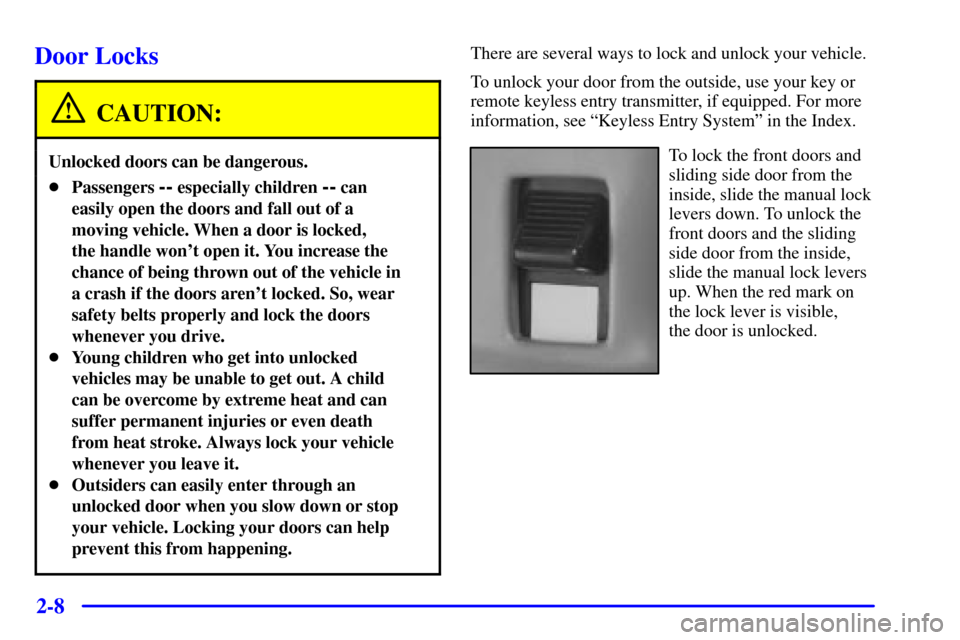Page 25 of 400

1-18
Q:If I'm a good driver, and I never drive far from
home, why should I wear safety belts?
A:You may be an excellent driver, but if you're in
an accident
-- even one that isn't your fault -- you
and your passengers can be hurt. Being a good
driver doesn't protect you from things beyond
your control, such as bad drivers.
Most accidents occur within 25 miles (40 km)
of home. And the greatest number of serious
injuries and deaths occur at speeds of less than
40 mph (65 km/h).
Safety belts are for everyone.
How to Wear Safety Belts Properly
Adults
This part is only for people of adult size.
Be aware that there are special things to know about
safety belts and children. And there are different
rules for smaller children and babies. If a child
will be riding in your vehicle, see the part of this
manual called ªChildren.º Follow those rules for
everyone's protection.
First, you'll want to know which restraint systems
your vehicle has.
We'll start with the driver position.
Driver Position
This part describes the driver's restraint system.
Lap-Shoulder Belt
The driver has a lap-shoulder belt. Here's how to
wear it properly.
1. Close and lock the door.
2. Adjust the seat so you can sit up straight.
To see how, see ªSeatsº in the Index.
Page 34 of 400

1-27
The best way to protect the fetus is to protect
the mother. When a safety belt is worn properly,
it's more likely that the fetus won't be hurt in a crash.
For pregnant women, as for anyone, the key to making
safety belts effective is wearing them properly.
Right Front Passenger Position
To learn how to wear the right front passenger's safety
belt properly, see ªDriver Positionº earlier in this section.
The right front passenger's safety belt works the same way
as the driver's safety belt
-- except for one thing. If you
ever pull the lap portion of the belt out all the way, you will
engage the child restraint locking feature. If this happens,
just let the belt go back all the way and start again.
Air Bag System
This part explains the air bag system.
Your vehicle has air bags
-- one air bag for the driver
and another air bag for the right front passenger.
Frontal air bags are designed to help reduce the risk of
injury from the force of an inflating air bag. But these
air bags must inflate very quickly to do their job and
comply with federal regulations.Here are the most important things to know about the
air bag system:
CAUTION:
You can be severely injured or killed in a crash
if you aren't wearing your safety belt
-- even if
you have air bags. Wearing your safety belt
during a crash helps reduce your chance of
hitting things inside the vehicle or being ejected
from it. Air bags are designed to work with
safety belts, but don't replace them. Air bags
are designed to work only in moderate to severe
crashes where the front of your vehicle hits
something. They aren't designed to inflate
at all in rollover, rear or low
-speed frontal
crashes, or in many side crashes. And, for some
unrestrained occupants, air bags may provide
less protection in frontal crashes than more
forceful air bags have provided in the past.
Everyone in your vehicle should wear a safety
belt properly
-- whether or not there's an air bag
for that person.
Page 68 of 400
1-61
5. Pull the rest of the lap belt all the way out of the
retractor to set the lock.6. To tighten the belt, feed the lap belt back into the
retractor while you push down on the child restraint.
You may find it helpful to use your knee to push
down on the child restraint as you tighten the belt.
7. Push and pull the child restraint in different
directions to be sure it is secure.
To remove the child restraint, just unbuckle the vehicle's
safety belt and let it go back all the way. The safety belt
will move freely again and be ready to work for an adult
or larger child passenger.
Page 81 of 400

2-8
Door Locks
CAUTION:
Unlocked doors can be dangerous.
�Passengers -- especially children -- can
easily open the doors and fall out of a
moving vehicle. When a door is locked,
the handle won't open it. You increase the
chance of being thrown out of the vehicle in
a crash if the doors aren't locked. So, wear
safety belts properly and lock the doors
whenever you drive.
�Young children who get into unlocked
vehicles may be unable to get out. A child
can be overcome by extreme heat and can
suffer permanent injuries or even death
from heat stroke. Always lock your vehicle
whenever you leave it.
�Outsiders can easily enter through an
unlocked door when you slow down or stop
your vehicle. Locking your doors can help
prevent this from happening.
There are several ways to lock and unlock your vehicle.
To unlock your door from the outside, use your key or
remote keyless entry transmitter, if equipped. For more
information, see ªKeyless Entry Systemº in the Index.
To lock the front doors and
sliding side door from the
inside, slide the manual lock
levers down. To unlock the
front doors and the sliding
side door from the inside,
slide the manual lock levers
up. When the red mark on
the lock lever is visible,
the door is unlocked.
Page 87 of 400

2-14 Sliding Door Security Lock
Your vehicle is equipped
with a sliding door security
lock that helps to prevent
young children or other
passengers from opening
the sliding door using the
inside door handle.
The security door lock is located near the front of the
sliding door.There are two labels on your vehicle to remind you that
you have this feature. One can be seen from the outside
on your sliding door. It is located near the bottom of the
door glass, toward the front of the door. The other label
is located on the front of the sliding door, near the
security door lock.
This feature prevents passengers from opening the
sliding side door from the inside.
To use this feature, do the following:
1. Move the lever all the way up.
2. Close the door.
To open the sliding side door while the security lock is
engaged, unlock the door and open it from the outside.
If you don't cancel the security lock feature, adults or
older children who ride in the rear won't be able to open
the sliding door from the inside. You should let adults
and older children know how the security door lock
works, and how to cancel the lock.